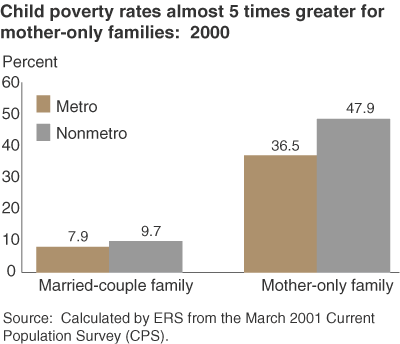Dimensions of Child Poverty in Rural Areas
- by Carolyn Rogers
- 11/1/2003
With a child poverty rate much higher than that of the general population, the Nation has much to gain from improving the economic conditions of children and their families. Child poverty is closely linked to poorer health, difficulty in school and low educational achievement, behavioral and emotional problems, and delinquency. Poor children are more likely to need public assistance, and as adults, to earn less and be unemployed more frequently than children brought up in families above the poverty line.
Child poverty rates vary across rural and urban areas. Rural or nonmetropolitan (nonmetro) areas have historically had higher poverty than urban or metro areas partly due to higher rural unemployment and a greater share of low-wage jobs in rural areas. The share of rural children in families with incomes below the poverty level declined from 22 percent in 1990 to 19 percent in 2000. An expanding economy and welfare reform in the 1990s both helped reduce the rate. However, the rural child poverty rate remains higher than the urban rate (19 percent versus 15 percent). In 2000, 2.7 million rural children (under 18) were poor, representing 34 percent of the rural poverty population.
Within nonmetro areas, child poverty rates rise as the area becomes more rural. Rates in 2000 ranged from 17 percent in counties with populations of 20,000 or more and adjacent to an urban (metro) area to 23 percent in completely rural counties. Proximity to an urban area also affects rural poverty rates. Regardless of nonmetro population size, counties not adjacent to an urban area had higher child poverty rates than adjacent counties.
Childhood poverty is associated with two major demographic factors—ethnic minority status and female-headed families. Black children and Hispanic children are disproportionately poor relative to their share in the general population. In nonmetro areas, Black children and Hispanic children are about twice as likely to be poor as are White children. Additionally, nonmetro children in mother-only families are more likely to live in poverty than are children in two-parent families. In many mother-only families, mothers often have low earnings, fathers may not contribute to family support, and financial assistance may be insufficient. When only one parent generates income, that effort is often compounded by child care responsibilities.
While child poverty has declined in the 1990s, it still warrants attention because children are more likely to be poor than any other age group. A better understanding of the dimensions of child poverty is important in designing effective public assistance programs. In hard-to-serve rural areas, special efforts may be needed to reach the poor.
This article is drawn from:
- Rural Poverty & Well-Being. (n.d.). U.S. Department of Agriculture, Economic Research Service.



